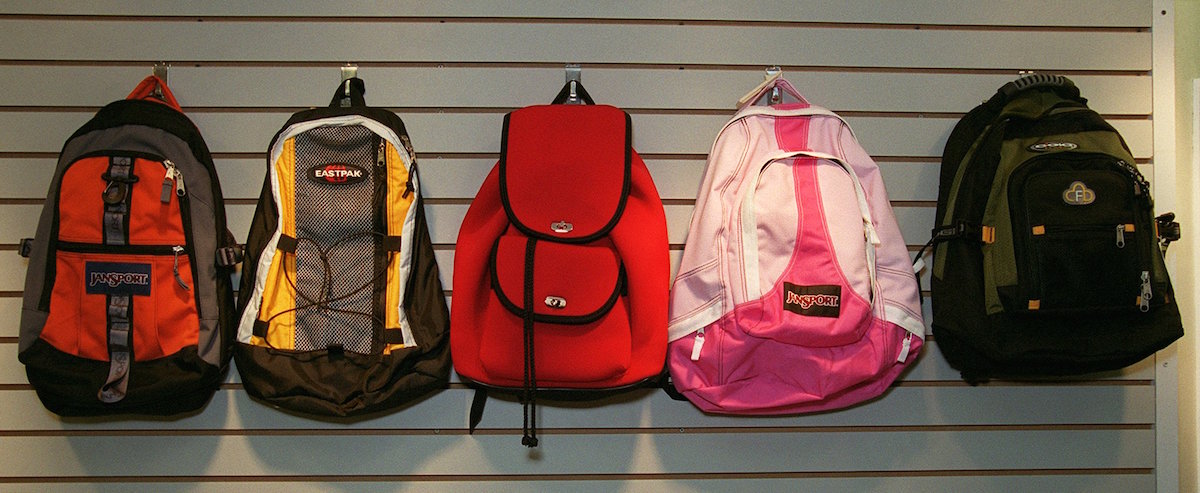
Backpacks are a staple for many types of people: working professionals, travelers, hikers and, most of all, students. While the idea of strapping your gear to your back is older than we can say, the modern student backpack is quite young—only about 44 years old—and has seen many new fads and changes in a short amount of time. From leather straps to JanSport packs, here’s a look at how students have carried their books through the years:
The first vessels for students’ books weren’t pack-like at all, but rather a strap of leather or cloth (basically a belt) that was fastened around a stack of books to make them easier to carry. Straps remained in use for many decades (viewers of Netflix’s The Get Down, which is set in the 1970s, may have noticed that Ezekiel carries his books to school with a book-strap), but they eventually went out of fashion.
In 1938, when Gerry Outdoors invented the first backpack with a zipper, backpacks were still primarily in use for hiking, camping and alpine recreation. Between the 1930s and ‘60s, some kids also made use of canvas or leather bags with a single strap, miniature briefcases that were usually called satchels, for trips to and from school. Some students could also be seen carrying their academic luggage on their backs in squared leather bags, fastened shut with buckles.
But by and large students were stuck toting their supplies by strap or by hand. In the book The Hippie Guide to Climbing the Corporate Ladder and Other Mountains: How JanSport Makes It Happen, the original JanSport salesman Skip Yowell wrote that in 1972, “students had no choice but to tote their textbooks and notebooks around campus with their hands. Some tied a belt around them or clutched them to their chests as they walked.”
Everything changed when the first lightweight nylon daypack was invented, blowing the door wide open for backpack redesign. Gerry Outdoors claims to have created the very first “modern nylon backpack in existence” in 1967 (the same year JanSport opened up shop). The smaller and lighter backpack caught on among other gear brands, and became immensely popular among outdoor enthusiasts.
JanSport, the world’s largest backpack maker, created their own lightweight nylon daypacks around this same time, designs that eventually evolved into the student backpacks we know today.
Get your history fix in one place: sign up for the weekly TIME History newsletter
Yowell writes in his book that college students at the University of Washington began to use JanSport daypacks (smaller, lighter versions of heavy-duty backpacking packs) to lug their school-stuff around campus. The campus sporting goods store had been selling the packs with student hikers in mind, but students co-opted them for school luggage as well. Noting the trend, the school’s sports-shop manager made recommendations that prompted the company to create packs tailored to the needs of students. The trend stuck and spread far and wide, sparking a nationwide movement towards backpacks designed for students and their many supplies. By the 1980s, student backpacks were fully integrated into the checklist of necessary school supplies.
While the original student backpack came about organically in response to practical student needs, novelty backpacks that are made mostly with aesthetics in mind have become popular in more recent decades. Backpacks that feature shiny images of favorite children’s TV and movie characters demonstrate the ways in which back-to-school has been commercialized, and is marketed as a fun, sometimes whimsical time for young people. Backpacks aren’t just about the business of carrying things to school anymore. They’re a part of a student’s identity.
But things may be changing once again.
Now, in an age where schools are relying more and more on digital tools, designers are rethinking backpacks, creating smaller, sleeker bags with compartments for laptops and smartphones built in. Backpack companies are also beginning to sell accessories that supplant backpacks for students of the digital age, such as JanSport’s “Digital Burrito” designed for students who just aren’t carrying many books but need mobile storage for their devices.
The evolution of backpacks from a simple strap to back-to-school basic—and, possibly, to obsolete remnant of the pre-digital age—reveals that backpacks can carry a lot more than books: they’re also a symbol of changing expectations for students and for the education system as a whole.
More Must-Reads from TIME
- Donald Trump Is TIME's 2024 Person of the Year
- Why We Chose Trump as Person of the Year
- Is Intermittent Fasting Good or Bad for You?
- The 100 Must-Read Books of 2024
- The 20 Best Christmas TV Episodes
- Column: If Optimism Feels Ridiculous Now, Try Hope
- The Future of Climate Action Is Trade Policy
- Merle Bombardieri Is Helping People Make the Baby Decision
Contact us at letters@time.com